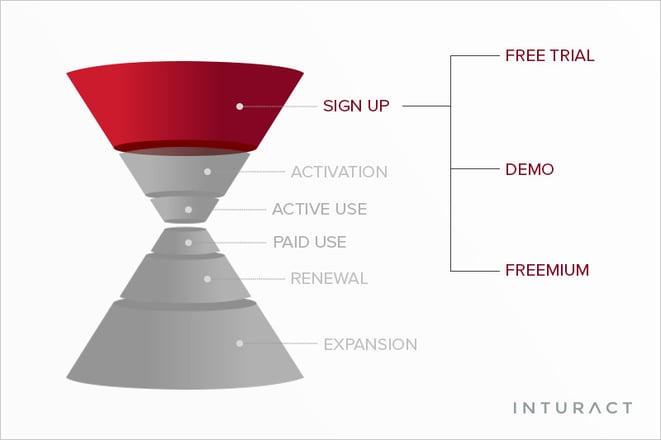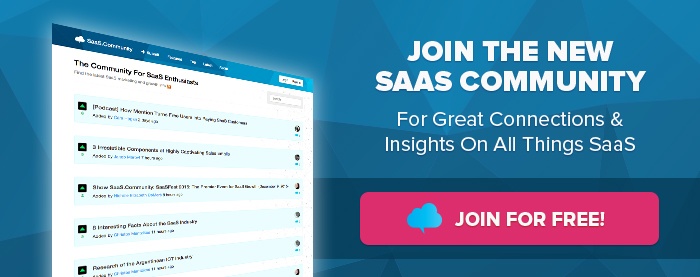
In the last post we talked about the top pricing strategies for your software as a service (SaaS) product. But before you can earn money from your customers, you need to entice them in. Today, let's look at a few of the marketing strategies companies use to attract customers, starting with the free trial and the demo.
Free Trials in SaaS Marketing
Many SaaS companies use a limited free trial to get potential customers to use the product. Some offer a full version of the product for a short time, while others offer a cut-down version of the product with a teaser to the additional features you can unlock.
One question to consider is how long your free trial should be. Most range between 7 and 30 days (with 30 as an average), though some may be even longer. The ideal length will depend on your customers, so you have to do your own research to figure out the ideal free trial length.
Another key question is whether you should ask people for credit card information before letting them have a free trial. Totango's research on this suggests you shouldn't. It shows that:
-
Out of 10,000 visitors, only 2% will sign up for the trial if you ask for a credit card. Of these, half will convert to paid customers, and you will retain 60% of those after 90 days.
-
If you don't ask for a credit card, 10% will sign up for the free trial, 15% will convert to paid customers, and 80% will still be customers after 90 days.
-
Best in class SaaS companies get 10% to sign up for the trial, 25% to convert to paid customers and 80% to remain at the end of 90 days.
The research suggests that the best approach is not to gate the free trial and then to focus on the people who are using the product. Lincoln Murphy agrees. Since the free trial is part of the marketing effort, it's important to market to customers throughout the trial, and not just at the end.
In other words, the free trial is part of the funnel that encourages customers to upgrade for additional features or storage. If you keep customers engaged with emails about tips and features, reminders about the expiry of the trial and options for extending the trial, that can have great results.
One thing that makes free trials fail, says Hubspot is when people can't test your software properly. From the user's viewpoint, a full featured free trial helps them truly understand how the product works, while limiting the features may also limit their interaction. It's also essential to support the free trial via content marketing and email marketing campaigns specifically geared to free trial users. Unbounce and Kissmetrics agree and suggest:
-
emailing users immediately and providing tips on getting started
-
using personalization and a clear call to action
-
sending multiple emails
-
using webinars
-
getting feedback from new users
-
providing discounts for new users
An automated drip marketing campaign can help with this.
Winning Users with a Product Demo
Back in the old days, vacuum cleaner salesmen would go door to door and show how their products saved time and picked up dust. It was the best way to make sales - and it's a method that still works. In fact, sometimes it's the only way to get customers to understand what your product can do for them.
Woopra has another analogy, urging SaaS marketers to learn from drug dealers and give potential customers enough of a taste that they want to try it again. Even if you don't like the analogy, the point is clear: there's a place for product demos in SaaS marketing.
So what are your options? Capterra outlines three:
-
Using product videos, such as a video library showing someone using the different product features.
-
Having a 1 on 1 call while sharing your screen
-
Creating a product walkthrough presentation.
And of course, you can also have an introductory webinar with multiple participants.
Like the free trial, the demo is part of the marketing funnel. Keys to success with a product demo include:
-
keeping it short. Most people don't want the time for long, complicated explanations. They want to quickly understand how your product will help them.
-
focusing it on the key features that matter most to the customer, highlighting those so they can try them themselves later.
-
identifying the benefits they will get from the product.
The goal is to get people to feel comfortable using the software so they will be interested in making a long-term commitment.
Support your demo in the same way as the free trial, with content marketing and email marketing resources before, during and after to help your customers.
No Trial, No Demo? Try Freemium
Free trials and demos are common, but there's a third option that's also popular in SaaS marketing: going freemium. That's got big advantages for users, but the benefits to companies aren't always so clear. For users, it means they get a great product that's basically free, but how does that help companies make money? Mostly, it doesn't.
As Justin Mares points out, freemium can be a bad idea because people who get your product for free don't upgrade, because they use up a lot of support resources and they cost you money. However, used wisely, he says, SaaS marketers can get something useful from the freemium model. Some benefits include:
-
a built-in testing program with a large user base. That helps you with product development
-
a way to figure out what will trigger upgrades (such as greater insight, improved security or increased storage)
-
a way to test your referral process
A large user base can also help SaaS creators looking to cash out early.
Of course, there's no reason why freemium has to stand alone. You can use different types of freemium models so you get some revenue and even combine freemium with other SaaS pricing models.
One last thing to note is that it can take a long time for users to convert from freemium to paid. With Evernote, for example, the average conversion period is a couple of years.
Which Should You Choose?
So which model is right for you? It depends on what you are looking to gain. Only you can decide whether you're looking to grab a large user base quickly with freemium, grow more slowly by targeting the right users via product demos or take the middle ground with a free trial. Let Lincoln Murphy have the final word:
"remove barriers to entry, reduce friction, and get your prospective customers to a point where they realize – or at least recognize the potential for – value as quickly as possible."
Which model are you using in your SaaS marketing?



